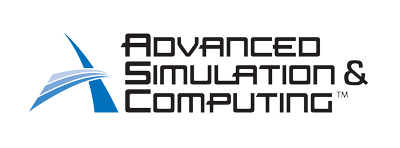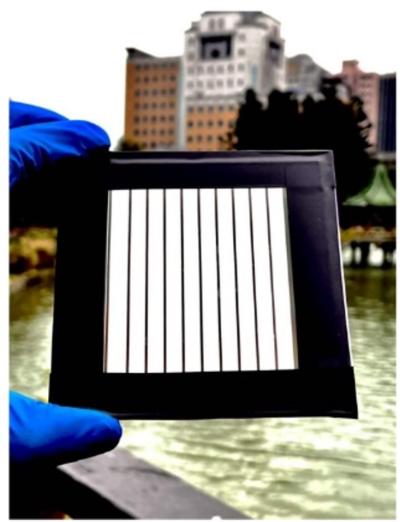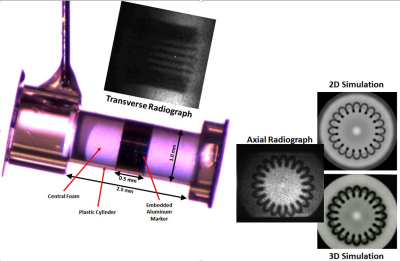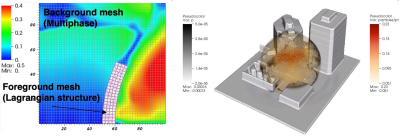
OFFICE OF ADVANCED SIMULATION AND COMPUTING AND INSTITUTIONAL R&D PROGRAMS (NA-114)
Quarterly Highlights | Volume 4, Issue 2 | May 2021
In This Issue
SNL analysts simulated B83 shock and vibration environments, leading to an on-time SFI closure
LLNL’s metal research benefits ASC codes for HED compression experiments
A new tool improves LANL’s 3D weapon safety analysis
Improved electromagnetic pulse calculations at SNL help support stockpile stewardship and the SCDS
LANL Common Modeling Framework offers capabilities for designing new systems
LANL’s new fabrication method paves way to large-scale production of perovskite solar cells
LLNL team explores the source of asymmetries in ICF implosions
ASC & LDRD Community—Upcoming Events (at time of publication)
- ASC Virtual Technical Seminar: Unsplit Hydro in EAP codes, J. Dolence (LANL); June 9
- ASC Virtual Technical Seminar: ASC Roadmaps for W80-4 Qualification, P. Hough (SNL); June 21
- CSSE/FOUS Virtual Program Review; June 22-23
- International Supercomputing Conference 2021 (virtual); June 24-July 2
- Virtual JOWOG 34 meeting via Microsoft Teams, arranged by LLNL; July 12-16
- ASC Virtual Technical Seminar: Using Machine Learning for Radiographic Analysis and Identification of Material Fracture, K. Lewis (LLNL); July 14
- Virtual DOE Computational Science Graduate Fellowship (CSGF) Virtual Annual Program Review (via Zoom); July 19-22
Questions? Comments? Contact Us.

Welcome to the second 2021 issue of the NA-114 newsletter - published quarterly to socialize the impactful work being performed by the NNSA laboratories and our other partners. This issue begins with a highlight from the Sandia National Laboratories (SNL) regarding B83 shock and vibration environment simulations that assisted in the on-time closure of a Significant Findings Investigation (SFI). Also highlighted is Lawrence Livermore National Laboratory’s (LLNL’s) research regarding a new mechanism of solidification in copper that alters our fundamental understanding of nucleation at high pressure – aiding ASC codes used for high-energy density (HED) experiments (a snapshot of the associated molecular dynamics simulation is shown in the banner image above). Other highlights include:
- Los Alamos National Laboratory’s (LANL’s) new tool, Rapid Iterative Feedback Tool (RIFT), developed to help weapon safety modelers quickly compare simulation results with experimental results, improving 3D weapon safety analysis.
- LANL’s 3D modeling of HED cylindrical implosion experiments to be used to evaluate the impact of different modeling choices and to help make cost-effective decisions on future computer use.
- SNL’s SIERRA/Solid Mechanics new capability reducing the complexity of specifying bolt preloads for abnormal mechanical use cases (e.g., crashes, drops, and other mechanical impacts), enabling improved simulation robustness and simplicity for W80-4 analysts.
- Improvements to SNL’s radiation transport code supporting analysis of electrical effects and radiation shielding and the Stewardship Capability Delivery Schedule (SCDS) Hostile Survivability 2020 Pegpost.
Please join me in congratulating the dedicated professionals who delivered the achievements highlighted in this newsletter, in support of our national security mission.
Thuc Hoang
NA-114 Office Director
SNL analysts simulated B83 shock and vibration environments, leading to an on-time SFI closure, with rapid delivery of results for a critical component while maintaining conservative estimates of margin
To aid in the closure of a B83 SFI involving a broken screw, researchers at SNL have simulated shock and vibration Stockpile-to-Target Sequence (STS) scenarios to estimate the slip of a critical component. To manage uncertainties that are present in material responses, experimental data, environment approximations, and numerical estimates, this problem was approached using a combination of bounding approximations and uncertainty quantification in the simulations. This, in turn, allowed the analysts to provide the necessary results to the B83 system group in weeks, rather than months or years, while maintaining conservative estimates of margin. To bridge the computationally limited simulation time domain (1 second) to actual environments (hours or days), the slip is extrapolated using advanced statistical methods. These simulations allowed for reduced testing; only characterization of the friction coefficient was needed (sponsored by the B83 system engineering group) instead of a full set of shock and vibration experiments. As a result, the SFI was closed on schedule. (SAND2021-0265 O)
LLNL scientists’ discovery of a new way that metals freeze at extreme conditions benefits ASC codes used for HED compression experiments
In recent research to be published in the Proceedings of the National Academy of Sciences, LLNL researchers Babak Sadigh, Luis Zepeda-Ruiz and Jon Belof discovered a new mechanism of solidification in copper that alters the fundamental understanding of nucleation at high pressure. Simulations of the nucleation process, run on the graphics processing units (GPUs) of the LLNL supercomputer “Lassen” reveal that nucleation first occurs through a body-centered cubic phase that is unstable. This contrasts with the usual view that a metal will nucleate in the phase that is most favorable in free energy as typically represented through the phase diagram of a substance.
“This result was surprising, because it has forced us to rethink the basis for phase stability at high pressure – under these extreme conditions, the phase diagram sort of goes out the window,” explains Jon Belof, the project Principal Investigator (PI) for phase transition kinetics and the equation of state (EOS) Program Leader under the ASC/Physics & Engineering Models (PEM) Program at LLNL. To better explain the new finding, lead author Babak Sadigh developed a modification to classical nucleation theory that includes the metastable phase production. The new nucleation model has been implemented into the LLNL kinetics code Samsa, which is utilized by the ASC code Ares for 3D simulation of HED compression experiments. Future dynamic experiments at the National Ignition Facility (NIF) and Linac Coherent Light Source (LCLS) will be conducted in FY21 to validate the new model for the kinetics of solidification in copper under ramp compression. More information is available in a video trailer on LLNL’s YouTube channel: https://youtu.be/p8464iagt34. (LLNL-VIDEO-819235, LLNL-ABS-821715)
A new tool improves LANL’s 3D weapon safety analysis
One of the greatest challenges within the safety community is providing a rapid response to weapons safety questions. Answering a safety inquiry from a production facility commonly requires dozens of large 3D simulations. The fast, accurate codes of the LANL Safety Applications Project (SAP) and the availability of LANL high-performance computing (HPC) machines make such a daunting task feasible within one or two weeks. A separate challenge is that development of a new 3D experiment requires many iterations. The terabytes of results from these simulations must then be processed to prepare for the experiment or answer questions from production facilities.
A new tool, called the Rapid Iterative Feedback Tool (RIFT), has been developed to help safety modelers quickly compare simulation results with experimental results, such as the Halfpipe experiment shown in the figure on the right. This allows modelers to spend less time manipulating large datasets and more time focusing on the important physics in the simulations. The tool automatically detects and extracts surface features from the results of a 3D simulation and uses ray tracing capabilities to improve comparisons to radiographic images. A graphical user interface (GUI) is provided so that the user can customize the overlay of the simulation results with the experimental data. RIFT is parallelized so that it can process large datasets in a short period of time, such as seconds to minutes instead of the hours to days it takes to do so by hand. (LA-UR-21-22244)
LANL 3D modeling of HED cylindrical implosion experiments to be used to help make cost-effective decisions on future computer use
The V&V Program is using 3D simulations of cylindrical implosion experiments in the HED regime to help validate the 3D hydrodynamics in LANL’s Eulerian radiation-hydrodynamics code.
Accurate modeling of hydrodynamic instability growth in convergent geometries is essential for many applications in the Stockpile Stewardship Program. LANL is fielding laser-driven cylindrical implosion experiments at the OMEGA laser facility and the NIF to study instability growth in the HED regime. Radiographic images from two different lines of sight provide valuable information used to evaluate the impact of different modeling choices. The experiments were designed to be nearly 2D. This allows a comparison of the relative accuracy of 2D simulations against 3D simulations when small amounts of 3D effects are present. Such evaluations will assist in determining under what conditions the more expensive 3D simulations may be warranted as a supplement to the standard 2D modeling.
(LA-UR-21-20949)
More intuitive and accurate abnormal mechanical W80-4 workflows enabled by improved ASC capabilities at SNL
Typical nuclear weapon system models, and in particular those of the W80-4, require a preloading step to properly simulate the starting conditions for abnormal mechanical use cases (e.g., crashes, drops, and other mechanical impacts). The SIERRA/Solid Mechanics team worked with W80-4 analysts to address areas of concern in their preload workflow. The team provided a new capability that greatly reduces the complexity of specifying bolt preloads (pictured on right). W80-4 analysts report improved simulation simplicity, credibility, and robustness. Simplified syntax removed approximately 40 lines from analyst input files per bolt, and the new syntax incorporates preload setup steps that previously required a combination of multiple computational tools. The new preload capabilities are in use by the W80-4 and W88, and are planned for use by the W87-1. (SAND2021-1145 O)
Improved electromagnetic pulse calculations at Sandia help support stockpile stewardship and the Stewardship Capability Delivery Schedule
Improvements to Sandia’s radiation transport code is providing analysts with more accurate and efficient radiation transport supporting multiple applications, notably electrical effects and radiation shielding. A new capability was used recently to provide improved agreement between measurement and calculation in a project supporting the SCDS Hostile Survivability 2020 Pegpost. This new capability virtually eliminates ray effects, which are notorious for certain radiation-transport problems (ray effects are a numerical artifact that can produce wildly inaccurate results in problems with isolated sources and streaming regions, such as cavities or voids). Additional enhancements to the radiation tool suite have resulted in a capability that is more user-friendly, reduces the learning curve, and lowers the barrier to entry for running deterministic radiation transport calculations. (SAND2021-1483 O)
Advanced Multidomain Coupling technique developed by LLNL ALE3D code team significantly improves multiphase flow capabilities for use in weapons effects studies
To better address the numerical modeling challenges posed by multiphase flows, an LLNL team has developed Advanced Multidomain Coupling or AMC (Kanarska et al., 2019) in the ALE3D code. AMC is a stable, multi-mesh coupling technique allowing a multiphase solver with point particle models (e.g., explosive gases) to interact with foreground deformable structures. At each cycle of the simulation, the intersection of the exterior boundary of the foreground mesh with the background mesh is computed resulting in a set of interface segments, which are portions of the exterior faces of the foreground mesh clipped to the background mesh cell in which they are contained. Discrete particles interact with those segments using appropriate bounce collision models with a general kinetic energy loss due to friction and inelasticity. Multiphase equations for explosive product gases are modified such that a solution of the Riemann problem satisfies exactly the multi-species boundary interface conditions at the faces. The method uses a partitioned approach with several advantages including low memory requirements, low computational cost, and high parallelism efficiency because a global system of equations is not needed. Since the coupling occurs only through joint surfaces and overlapping domains, well tested single physics solvers can be used, with each solver remaining separate and operating on its own domain. For example, a solid model used for structural mechanical calculations in ALE3D enables continuum damage mechanics and provides a theoretical framework for developing damage and failure models for structures and rock material. As shown in the figure below, this model coupled to a multiphase background mesh can effectively simulate the blast and explosive-driven particle interaction with deformable structures (for the idealized thin plate on the left, or much more complex city structures on the right). (LLNL-ABS-821754)
LLNL Cheetah code team enables advanced high explosive models for use in highly resolved 3D weapons program simulations through optimized use of GPUs
Final testing and optimization of the Cheetah code for GPUs is underway as part of a PEM FY21 Level 2 Milestone. It is anticipated that Cheetah will deliver substantially accelerated performance on GPUs, allowing the Cheetah code to be applied to problems requiring highly-resolved 3D simulations that are not currently possible. Preliminary results show GPU speedups of more than 10 times over single CPUs, with improvements being made rapidly. This will enable more sophisticated stockpile analysis of a wider range of scenarios.
The Cheetah high explosive (HE) code can operate within the ARES and ALE3D multiphysics codes to offer advanced HE EOS and burn kinetic models. The Cheetah code is based on advanced, sophisticated, on-demand physics algorithms. It calculates chemical equilibrium between reacting chemical species that involves solving stiff nonlinear equations. The equilibrium calculations are stored in a sparse EOS database that is used to answer future queries and reduce the number of chemical equilibrium solutions that need to be executed. Use of the database increases the speed of the HE detonation response function evaluations 10,000 times over direct numerical solution of the physics equations.
There are numerous challenges to porting a sophisticated and advanced physics package, such as Cheetah, to GPU-based computer architectures. The original library interface relied on a single function call per zone, which was not well suited for advanced GPU architectures that efficiently process long vectors of operations. To improve Cheetah’s performance on GPU architectures, the Cheetah team developed a vector interface, which allows millions of zones to be processed together. Vector loops were dispatched to the GPUs using LLNL’s RAJA utility to abstract CUDA calls, thereby maintaining code readability and avoiding host-specific code as much as possible. The evaluation of chemical kinetic rates was vectorized, and a new interpolation-based kinetic solver was developed for computationally intensive rate processes.
The population of the EOS databases were dispatched to the GPUs using asynchronous threading. This allowed the complex logic of the equation solutions to be maintained while taking advantage of the GPUs substantial computing power. An ability to fill in a database, in parallel, was added to the code for optimal efficiency during hydrodynamic simulations. (LLNL-ABS-821766)
LANL’s Common Modeling Framework now offers capabilities for designing new systems

LANL’s Common Modeling Framework (CMF) has been developed to house both current and historical experimental setups as well as a variety of modeling strategies used within LANL codes for different applications. In addition to the model archiving and simulation strategies available for performing assessments in CMF, there has also been a desire to use the framework for exploratory work related to several new prototyping and design efforts. For the first time, CMF has now been extended to provide the capability for design optimization.
A suite of secondary design tools has been developed within CMF that facilitates quick turnaround design scoping and optimization. The goal of these tools is to let the computers do what they do best (which includes quickly setting up, running, and automatically post-processing potentially large suites of runs), thus allowing the designers to focus instead on the physics implications of potential design choices and analysis of results. The Python-based customization capabilities within CMF easily facilitate this and other design work, making CMF a powerful tool not only for assessment but also design. This suite of tools is being used for ongoing design studies and exercises, and will be used extensively for the upcoming Phase 1 design work for the W93. (LA-UR-21-21689)
Collaboration between SNL and the Kansas City National Security Campus on improved contact algorithms speeds up simulations tenfold and increases simulation accuracy
Various production process simulations, including flex cable bending during installation and optimization of direct ink write (DIW) pad extrusion parameters, involve very complex contact, which has historically resulted in very slow simulation times. The same processes tend to require a large number of simulations to explore and characterize the impact of various production process parameters. Kansas City National Security Campus (KCNSC) team provided these production simulation challenges as a critical use case to their counterparts at SNL. The SIERRA/Solid Mechanics team conducted a software sprint to develop a fast and robust solution for the next software release and provided KCNSC with a reliable implicit contact script. As a result, KCNSC was able to implement these changes to provide the Defense Programs Product Realization Teams (PRTs) with more accurate results for 10 times as many cases as would have been previously possible. These efforts will increase the likelihood that the products will meet all requirements and have the capability to provide valuable insight in a matter of hours and days, as opposed to weeks and months. (NSC-614-3361)
New fabrication method at LANL paves way to large-scale production of perovskite solar cells
A new, simpler solution for fabricating stable perovskite solar cells overcomes the key bottleneck to large-scale production and commercialization of this promising renewable-energy technology, which has remained tantalizingly out of reach for more than a decade.

“Our work paves the way for low-cost, high-throughput, commercial-scale production of large-scale solar modules in the near future,” said LDRD researcher Wanyi Nie, who is the corresponding author of the paper, which was recently published in the journal Joule. “We were able to demonstrate the approach through two mini-modules that reached champion levels of converting sunlight to power with greatly extended operational lifetimes. Since this process is facile and low cost, we believe it can be easily adapted to scalable fabrication in industrial settings.”
Perovskite photovoltaics, seen as a viable competitor to the familiar silicon-based photovoltaics on the market for decades, have been a highly anticipated emerging technology over the last decade. Commercialization has been stymied by the lack of a solution to the field’s grand challenge: scaling up production of high-efficiency perovskite solar cell modules from the bench-top to the factory floor.
The team, in collaboration with researchers from National Taiwan University (NTU), invented a one-step spin coating method by introducing sulfolane as an additive in the perovskite precursor, or the liquid material that creates the perovskite crystal through a chemical reaction. As in other fabrication methods, that crystal is then deposited on a substrate.
The new process allowed the team to produce high-yield, large-area photovoltaic devices that are highly efficient in creating power from sunlight. These perovskite solar cells also have a long operational lifetime.
Through a simple dipping method, the team was able to deposit a uniform, high-quality perovskite crystalline thin film covering a large active area in two mini-modules, one of about 16 square centimeters and the other nearly 37 square centimeters. Fabricating uniform thin film across the entire photovoltaic module’s area is essential to device performance.
The mini modules achieved a power conversion efficiency of 17.58% and 16.06%, respectively—among the top reported to date. The power conversion efficiency is a measure of how effectively sunlight is converted into electricity.
For other perovskite fabrication methods, one of the major roadblocks to industrial-scale fabrication is their narrow processing window - the time during which the film can be laid down on the substrate. To get a uniform crystalline film that’s well bonded to the layer below it, the deposition process has to be strictly controlled within a matter of seconds.
Using sulfolane in the perovskite precursor extends the processing window from 9 seconds to 90 seconds, forming highly crystalline, compact layers over a large area while being less dependent on the processing conditions. The sulfolane method can be easily adapted to existing industrial fabrication techniques, which helps to pave the path toward commercialization. Work performed by Wanyi Nie and Shreetu Shrestha was supported by the LANL-LDRD program via project 20180026DR. (LA-UR-21-22266).
Livermore team explores the source of asymmetries in ICF implosions
Scientists are now one step closer to understanding the gap between simulations and inertial confinement fusion (ICF) experiments conducted at LLNL’s NIF due to LDRD-funded research aimed at analyzing experimental data to improve implosion performance.
ICF experiments aim to ignite a propagating fusion burn wave in deuterium-tritium fuel. To achieve ignition, the fuel must reach a self-heating state in which the energy produced exceeds energy loss from expansion, thermal conduction, and radiative cooling.
The best-performing ICF implosions have begun to show the effects of fusion self-heating, but these experiments still underperform on 2D simulations.
By analyzing data from several years of high-yield ICF experiments, researchers found a correlation between the velocity of the hot-spot implosion and the asymmetry of fuel areal-density (the combined thickness and density of the imploding frozen fusion fuel shell).
“We know that asymmetry is a principal degradation factor of implosion performance,” said LLNL physicist Dan Casey. “We found that 3D asymmetry does exist and is correlated between two key measurements. These results lay the foundation for subsequent work to track down the sources of the asymmetries.”
According to physicist Hans Rinderknecht, who conducted this work while serving as a Lawrence Fellow at LLNL, “We found that most of the implosions performed in the last three years at NIF had an unintentional asymmetry that ‘pushed’ the implosion to one side instead of imploding it uniformly, resulting in some wasted energy.”
Using two overlapping datasets—hot spot velocity versus density asymmetry—investigators started plotting them together, and “the shared pattern popped right out,” said Rinderknecht. “The two supporting datasets, from two different and independently vetted diagnostics, confirmed one another across so many shots with such different conditions that it became clear something real and significant was going on.”
More information regarding the team’s findings related to ICF implosions can be found on LLNL’s website. (LLNL-WEB-458451)
Questions? Comments? Contact Us.
NA-114 Office Director: Thuc Hoang, 202-586-7050
- Integrated Codes: Jim Peltz, 202-586-7564
- Physics and Engineering Models/LDRD: Anthony Lewis, 202-287-6367
- Verification and Validation: David Etim, 202-586-8081
- Computational Systems and Software Environment: Si Hammond, 202-586-5748
- Facility Operations and User Support: K. Mike Lang, 301-903-0240
- Advanced Technology Development and Mitigation: Thuc Hoang














